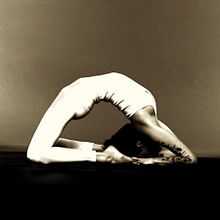Kapotasana
From Wikipedia, the free encyclopedia

Kapotasana
Kapotasana (Sanskrit: कपोतासन; IAST: Kapotāsana) or Pigeon Pose[1] is an asana.
Etymology
The name comes from the Sanskrit words kapota (कपोत) meaning "pigeon"[1] and asana (आसन) meaning "posture" or "seat".[2]
Description
Kapotasana is an asana which helps to open up the chest and also strengthens the back and groin. It opens and increases the flexibility of the hips, at the same time strengthening the back, and stretching the thighs and the groin.
See also
References
- ↑ 1.0 1.1 "Kapotasana A - AshtangaYoga.info". Retrieved 2011-04-09.
- ↑ Sinha, S.C. (1 June 1996). Dictionary of Philosophy. Anmol Publications PVT. LTD. p. 18. ISBN 978-81-7041-293-9. Retrieved 9 April 2011.
Further reading
- Iyengar, B. K. S. (1 October 2005). Illustrated Light On Yoga. HarperCollins. ISBN 978-81-7223-606-9. Retrieved 9 April 2011.
- Saraswati, Swami Satyananda (1 August 2003). Asana Pranayama Mudra Bandha. Nesma Books India. ISBN 978-81-86336-14-4. Retrieved 9 April 2011.
- Saraswati, Swami Satyananda (January 2004). A Systematic Course in the Ancient Tantric Techniques of Yoga and Kriya. Nesma Books India. ISBN 978-81-85787-08-4. Retrieved 9 April 2011.
External links
| |||||||||||||||||
This article is issued from Wikipedia. The text is available under the Creative Commons Attribution/Share Alike; additional terms may apply for the media files.